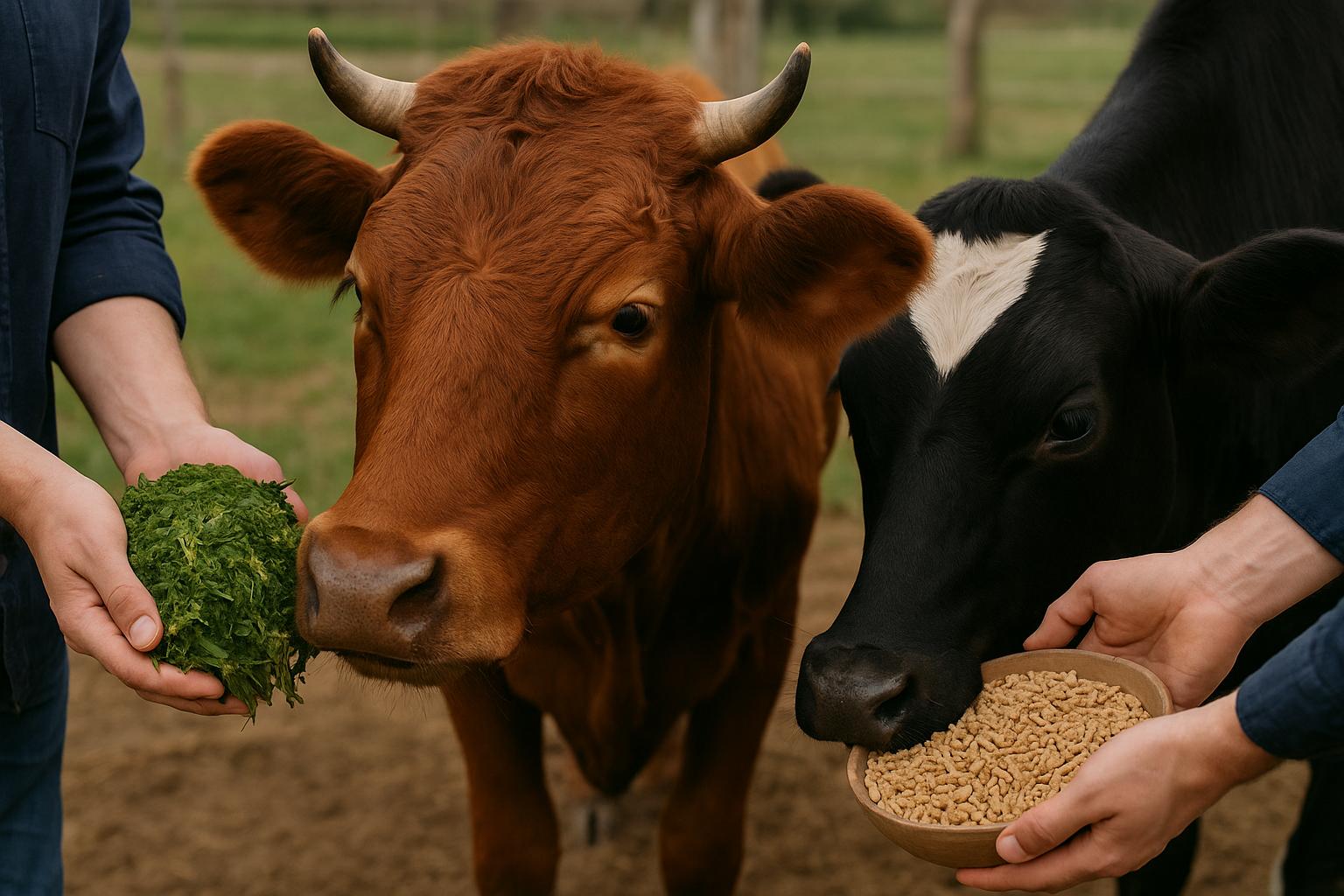Farmers across India and beyond often rely on what’s locally available—some feed hay or dry straws, while others focus on cultivating fresh, green fodder. However, feed planning needs to be more intentional than seasonal guesswork. Each type of feed has unique attributes, and your herd’s physiology responds to them differently.
Herd health, input costs, fodder waste, and long-term farm efficiency can all be maximised by recognizing the difference between green fodder and dry feed and when to use each.
It’s crucial to start with the appropriate source of nourishment. Purchase fodder seeds that are high in protein, drought-resistant, and appropriate for your agroclimatic zone is crucial if you’re organising your next production cycle or wish to enhance the quality of your green feed. Because of its excellent yield and nutritional value, hybrid Napier, Berseem, and CO-4 are frequently utilised in Indian systems.
What Is the Core Difference Between Fodder and Dry Feed?
Fresh, green plant matter that is fed directly to animals, such as grass, legume leaves, or new cereal plants, is referred to as fodder. For optimal nutrition, they are often plucked prior to blossoming and farmed seasonally. Conversely, hay, straw, and other dried plant concentrates or residues with a reduced moisture content and a longer shelf life make up dry feed.
Because green fodder usually contains 70–85% moisture, it is more appealing and easier to digest. Dry feed has a reduced initial digestibility but a higher storage potential because it includes less than 15% moisture.
Examples of Green Fodder:
- Hybrid Napier grass
- Maize or Sorghum leaves
- Berseem or Lucerne
- Cowpea shoots
Examples of Dry Feed:
- Wheat straw
- Paddy straw
- Hay from legumes or cereals
- Commercial concentrate feed
Both have distinct roles in animal nutrition, but their impact on herd performance varies.
Nutritional Value: Fodder Is Rich, But Dry Feed Is Reliable
Green fodder encourages quicker growth and higher-quality milk since it is rich in energy, digestible protein, and vitamins A and E. Despite being high in energy, dry feeds are deficient in vital vitamins and amino acids unless they are supplemented.
Better digestion and mineral absorption are facilitated by green fodder’s improved rumen motility and hydration. This is especially crucial for growing calves or nursing animals. However, animals must consume more food to meet their dry matter needs due to the high water content.
When utilized as the only diet, dry feed, such as wheat straw, reduces weight gain since it is low in protein and high in fibre. It is most effective when combined with supplements high in protein or beans. When green choices are unavailable in drought-prone locations, dry feed becomes a must for survival.
In integrated feeding systems, green fodder contributes 35–45% of total dietary requirements, while dry feed and concentrates make up the rest.
“Feeding your herd isn’t about what you have—it’s about what they need, at the right time, in the right form.”
Cost and Labor Comparison
Many farmers choose dry feed because it seems more economical and available year-round. But when analyzed over a full feeding cycle, green fodder—especially from your own land—is far cheaper per kilo of nutritional value.
A typical cost analysis shows:
- Green fodder grown on-farm: ₹1.5–2/kg
- Purchased hay: ₹6–8/kg
- Commercial concentrates: ₹20–25/kg
In the long run, green fodder can save feed expenditures by 30 to 40 percent, but it requires an initial investment in labour, seeds, and irrigation. Growing multi-cut cultivars lowers ongoing costs by producing multiple harvests from a single seed.
Dry feed makes sense for larger farms or emergency supplies because it is simpler to carry and store. Over-reliance on dry matter, however, might impact production and decrease feed intake efficiency.
Combining bulk dry feed and green feed from hydroponic trays might provide a well-rounded, economical option for farms with limited space.
Digestibility and Animal Health
Higher saliva production from green fodder helps to buffer the rumen’s pH. This enhances fermentation and lowers the possibility of gastrointestinal issues like bloating or acidity. Green feed’s cooling properties also aid in the summer by preventing heat stress and keeping animals hydrated.
Conversely, prolonged use of dry feed raises the possibility of impaction, constipation, and decreased appetite. In order to make up for the dryness, animals frequently drink more water, however this isn’t always effective.
However, if green feed isn’t balanced with roughage or concentrates, it can also result in loose stools or a metabolic imbalance. Total mixed ration (TMR) systems, which combine concentrate, dry, and green feed in ideal proportions, are therefore becoming more and more common.
According to the National Dairy Development Board (NDDB), TMR feeding has been shown to increase milk yield by 15–20% in organized farms, simply by correcting nutrient balance and improving palatability.
Storage and Shelf Life: Dry Feed Wins
There is one obvious area in which dry feed shines: long-term storage. Hay and straw can last up to a year if kept in dry, well-ventilated areas. They are therefore perfect for remote farms, lean seasons, or feed reserves during droughts and monsoons.
If not fed fresh, green fodder wilts in 24 to 48 hours. Fungal infections and nutrient loss result from storing it without ensiling or processing. In order to preserve nutrition and increase shelf life by up to six months, some farmers resort to silage, which is fermented green grass kept in airtight pits or bags.
As a fallback amid feed shortages, silage is becoming more and more popular among commercial dairy farmers. To prevent spoiling, the setup necessitates appropriate training and funding.
Impact on Milk Yield and Meat Quality
Farm productivity is directly impacted by feeding practices. Green fodder improves the digestibility, flavour, and proportion of milk fat. This is particularly true if the diet includes legumes like cowpea or Berseem. According to field tests, crossbred dairy cows produce 1.5 to 2.5 litres of milk per day more when fresh green is added to a dry foundation meal.
Diets balanced with dry and green feed increase muscle mass, decrease fat accumulation, and improve carcass quality in meat animals. Due to decreased protein digestion, dry feed alone frequently results in slower growth and less tender meat.
Rotational grazing on green forage followed by additional dry feed improves meat conversion and reproductive performance, even in sheep and goats.
Flexibility and Seasonality
Seasonal availability of feed is one of the main management challenges. Unless you’re growing in trays or utilising staggered sowing, it’s more difficult to retain green fodder throughout the year. On the other hand, dry feed may be stored and is not impacted by the seasons.
Nonetheless, you can grow green fodder for eight to ten months a year with careful planning, such as with winter Berseem or multi-cut CO-4 kinds. Drought-tolerant crops, such as Bajra Napier or Sorghum Sudan grass, perform well in arid areas even with little irrigation.
Because legumes absorb nitrogen and use less fertiliser in subsequent crops, using a combination of cereal and legume fodder enhances soil health in addition to feed diversification.
For fodder planning tools and region-specific crop calendars, the Indian Grassland and Fodder Research Institute offers valuable resources.
FAQs
- Is green fodder alone enough for high-yielding cows?
No. Green fodder is essential but must be combined with dry feed and mineral mix to meet the full dietary requirements of high-yielding cows.
- How much green fodder does one cow need per day?
An average cow needs 25–30 kg of green fodder per day, depending on weight and lactation status. This should be complemented with dry feed and concentrate.
- Can dry feed be soaked before feeding?
Yes. Soaking dry feed like straw for 30–60 minutes improves palatability and reduces dust inhalation. Some farmers also add urea-molasses treatment to improve nutrient content.
- What’s the shelf life of silage?
Properly stored silage lasts up to 6 months. Ensure airtight packing and proper fermentation to prevent spoilage or foul odor.
- Does green fodder help with animal fertility?
Yes. The vitamin and mineral content in fresh green feed improves ovulation, conception rate, and overall reproductive health in both male and female livestock.
Matching Your Feed Strategy to Your Farm’s Needs
Knowing when and how to use each is more important for the optimal feeding approach than choose between dry feed and green fodder. When it comes to animal health, digestibility, and nutrient content, green fodder excels. Dry feed provides minimum maintenance, quantity, and dependability. When combined, they can form a potent system that improves animal health, increases output, and reduces costs.
A commercial dairy with 100 heads might not benefit from the same practices as a small dairy with five cows. Determining the ideal balance will be aided by knowledge of your herd’s size, climate, land availability, and feed storage capacity.
Feeding ultimately aims to boost performance rather than only satisfy stomachs. Make the decision that will strengthen your farm year after year.
Check out more : Farming in a Virus-Heavy Climate: The New Rules for Survival



